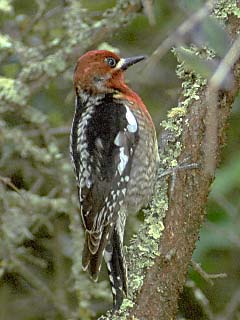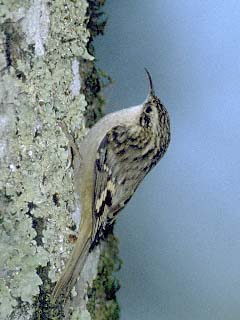ESC 451,
Fall Quarter 2003
Biology
and Conservation of Birds

American Kestrel
Assignments
Reading Assignments
| Date | Text Chapter Number |
| September 29-Oct 3 | 1-4 |
| October 6-10 | 5-7 |
| October 13-17 | 11-13 |
| October 20-24 | 14,17 |
| October 27-31 | 15,16,18 |
| November 3-7 | 19-21 |
| November 10-14 | 23 |
| November 17-21 | 24 |
| Due Date | Assignment | Things to Consider | ||
| October 10 | Answers to Text Chapter 2 (30 pt) | Concise but full answers | ||
| October 24 | Answers to Text Chapter 8 (30 pt) | Concise but full answers | ||
| November 3 | Natural history report (100 pt) | Depth of coverage, style & format of paper | ||
| November 7 | Journal article critique (50 pt) | Critical evaluation of approach,methods, data analysis & presentation, discussion and conclusions. | ||
| November 9 |
Answers to Text Chapter 9 (40 pt) |
Concise but full answers | ||
| December 5 | Team Research Presentation (100 pt) | Prepare powerpoint presentation, handout | ||
Chapter Questions should be typed!
Each question worth 10 points.
Chapter 2 Questions
1. List 5 anatomical characteristics that birds and reptiles have in common.
2. Discuss Archaeopteryx and why its discovery is so significant.
3. What is meant by "speciation"? Discuss an example of speciation given iin the text.
Chapter 8 Questions
1. Discuss the structure of the avian brain and how it compares with the brain of a mammal and a reptile.
2. Discuss the major parts of the avian eye and what they do.
3. Compare the sense of taste and smell between birds and mammals. Discuss the ecological implications of these differences.
Chapter 9 Questions
1. If you were from a different planet, how would you be able to tell that earthly birds use their vision for both species and individual recognition?
2. What is ritualized behavior and give 3 examples.
3. What is agonistic behavior and unuder what circumstances do birds employ it?
4. If you wanted to figure out the meaning of various visual displays given by a bird species, how would you go about studying it?
Guidelines for Natural History Report
My intent here is to get you familiar with a particular bird species or a group of closely-related species as well as the wildlife literature. The natural history report should include the following topics:
Classification (taxonomy)
Distribution (historical and present)
Normal habitat occupied
Reproduction
Population information
Interesting ecological facts
Conservation
Your paper should be concise and well-organized It would be a good idea to look at a few recent copies of the Condor to see the style you should follow. Your paper should be 5-10 pages in length. Use either 1.5 or double spacing. Use subheadings to delineate the major parts of the paper.
The Introduction puts your review into the proper context. In the case of this paper, you need not actually have a section entitled Introduction. Introductions usually try to describe the purpose of tre report. This is also the location where you state specific objectives of your literature research. By the time the reader has finished reading your introduction, he or she has a good idea what your paper is about and its significance. The main body of your paper should be the nuts and bolts of what you found. Use subheadings (e.g. the topics listed in dark brown above) to distinguish the various topics you discuss.
The Conclusion draws appropriate conclusions from the main body of the paper and should also refer back to your objectives. This section may in some cases be used to summarize/ The main emphasis, however, should be on what you want the reader to take away from your literature review. This is usually a broad interpretive statement of what the paper has shown.
The Literature Cited section includes a complete citation for every reference iin the paper. It should not include any citation not cited in your paper. There is much variation in the format of the Literature Cited section of journals. Use the format shown in the Condor. When citing a reference, it should be done this way: Jones (1999) found that...; or "similar observations have been made by others (Jones 1999; Smith and Robinson 2000)". Do not use footnotes unless it is in a table.
For this report, you should use a variety of sources but you can use only three internet sources and no encyclopedias. There are good references (books and journals) in the Allen Library as well as the Forest Resources Library in the basement of Bloedel Hall. You should have at least one journal article in your Literature Cited section.
The report is due November 3 and points will be deducted for late reports (10%/day).
The idea here is to critically review a study published in an ornithological journal. The paper is Roth, T.C. and S.L. Lima. 2003. Condor 105:474-483. The paper is on reserve in the Forest Resources Library in Bloedel Hall. Make a copy of it for your use.
Review each part of the paper and make some comments as to whether the section was written clearly and did what it was supposed to do. Evaluate all the sections of the paper. Note also figures and tables. Did they convey the right kind of information (also-too much, too little confusing?). Many of you won't have enought statistical background to pass judgement on that section. Don't worry about it; just move on to the next section. For a little guidance in this, read over my instructions on how to write a natural history report. The length should be 2-3 double-spaced pages. This critique is due November 7.
Guidelines for Bird Conservation Team Project: Powerpoint Presentation
The idea behind this exercise is to delve into a bird conservation issue and work as part of a team. Most teams will consist of 4 students. The ultimate goal is to produce an integrated Powerpoint presentation of the report. Each student will learn (if they don't already know) how to make such a computer-based presentation.
Each team should, through a literature review, include information on the basic natural history of the species of conservation concern and answer the following questions: 1) what was the historical distribution, and kinds of habitat occupied; 2) what caused the population to become a conservation concern; 3) what is being done to restore the population.
Pay attention to the social and political aspects as well as the ecological ones. Make sure you deal with the public agencies and private organizations that are involved in the conservation of the species.
No written report is required, only the Powerpoint presentation and a list of references to handout to the class. Each team member will be responsible for grading the other team members (form). The class as a whole will also provide an Evaluation. Grades will be submitted to the instructor who will keep the information confidential. The project is worth 100 points. Presentations will be made December 3, 5, 8 and 10. Two teams will present each day.
The structure of team presentation days will be:
12:30-12:50 Team Presentation
12:50-12:55 Evaluation
12:55- 1:15 Team Presentation
1:15-1:20 Evaluation
Example of previous completed student powerpoint presentation:
Last Updated:
10/01/03




Ponderosa pine woodland